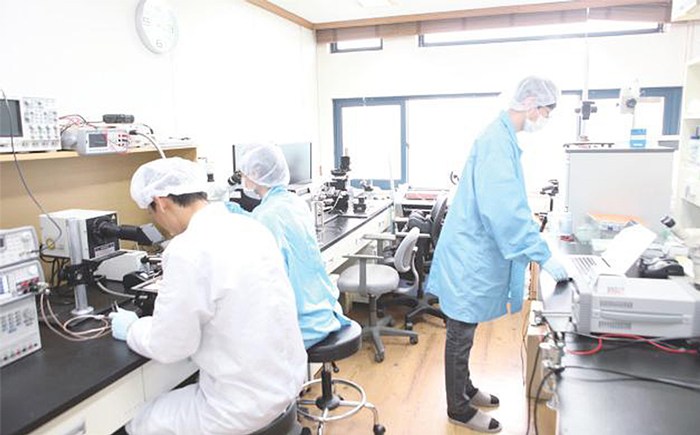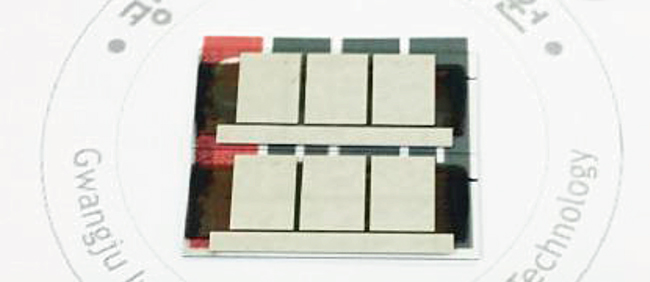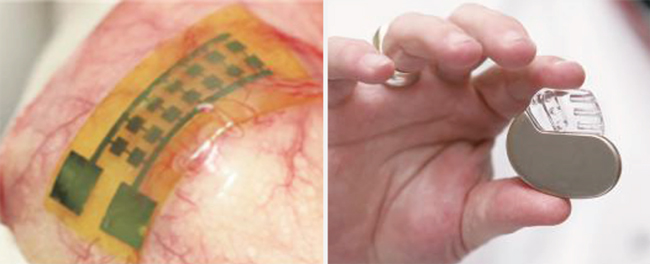You If you think about solar cells, you might imaginea blue color panels reflecting sunlight in a vast field.
Recent solar batteries however vary in their shapes as well as colors. They can operate not only outdoors but also indoors,
so they can be applied to a variety of fields such as clothing, packaging, wallpaper, and small electronic devices.
Recently, solar cells that can be inserted into a human body between 6 and 7μm thick have been developed, expanding their
range or applications. Currently, high efficiency and low cost are the keys to solar cell development, along with diversification of cells. We look at the current state of solar cell technology to solve problems.
Developing solar cells for insertion into humans
Expanding the applications for solar cells
Bio-Robotics Lab
Professor Jongho Lee
School of Mechanical Engineering
In May, a team led by School of Mechanical Engineering Professor Jongho Lee officially announced that they developed solar
cells for human implants. The new concept for solar cells was made with Korean technology and is expected to not only
expand the use of solar cells, which have mainly been been concentrated in the field of solar power, but will drastically improve the power shortage problem that has been a chronic problem in human-invasive medical devices. The research was supported by the Ministry of Science and ICT, the Core Space Technology Development Project, and the Research Institute for Solar and
Sustainable Energies. The results were published in the international journal 'Advanced Healthcare Materials.
What motivates you to research solar cells for human impants?
I was originally researching the solar cells by itself. When I accidentally turned on a flashlight over my skin, I saw part of the
light passing through. An idea then came to my mind that unlight passing through the body can be used for medical implants. Batters for edical electronic devices implanted inside the body, such as a cardiac pacemaker, only last 5 to 7 years.
The patient should have another surgery to replace the battery. If we can utilize the sunlight and produce electricity
autonomously, I thought that patients will suffer less financial and psychological burdens from not having more surgeries.
What parts have you focused on in your research?
I began my research with a question: "How much light can pass through the skin?" During my research however, there was a
paper published in Europe that found existing commercial silicon solar cells can be implanted into a body to produce energy.
The existing solar cells are thick and fragile, so there was always a risk of harm when inserted into a body. I was convinced that if we could solve this issue, we would succeed in developing a solar cell for human body implants.

To overcome these problems, a high-performance solar cell had to be separated from its hard substrate and incorporated into
film with a thickness of 6 to 7μm to provide skin-like flexibility. When inserted into a live mouse, the experiment showed that a
solar cell within 0.07㎠ (pure solar cell area) could produce a very high power of 647μW (micro-watts) with direct current. If the mouse receives sunlight for 2 hours a day, the power can operate a pacemaker 24 hours. But if it is combined with a small
rechargeable battery and a flexible pacemaker, we found that the pacemaker can be powered by a rechargeable battery even
in the absence of sunlight.
Which was most difficult about your research?
The research required a variety of background knowledge and skills, including machinery, electronics, materials, biology, and
medicine. For this reason, the research was conducted with various experts in Korea and abroad. In addition, during the development process, in order to analyze and verify the characteristics of human implanted solar cells, both positive (+) and negative (-) wires had to exposed through the outside of the mouse skin, and electrical characteristics analysis was difficult because some mice broke the electrical connections of the flexible wires.
Please tell us the research results and its expected benefits.
Solar cells have been developed for solar power generation. However, in this study, we designed and manufactured a flexible
solar cell in the form of a thin film for insertion into the human body, and it was meaningful to improve biocompatibility by
coating it with multiple transparent layers of film. In particular, analyzing and quantifying the electrical characteristics of the
solar cells under the skin through animal testing was the biggest achievement.
Lastly, please introduce your Bio-Robotics Lab.
Bio-robotics research aims to develop new types of robots,
nano-structures, and electronic devices with functions that
were previously impossible by basing them on biomimetic
engineering while developing useful technologies for real life.
The current research interests of the lab include bio-robotics
and controls, biomimicry nano/micro structures, and flexible/
neutral electronics. The ultimate goal is to integrate
technologies developed in each area into a biomimetric robot
or a biometric system to perform complex functions.








